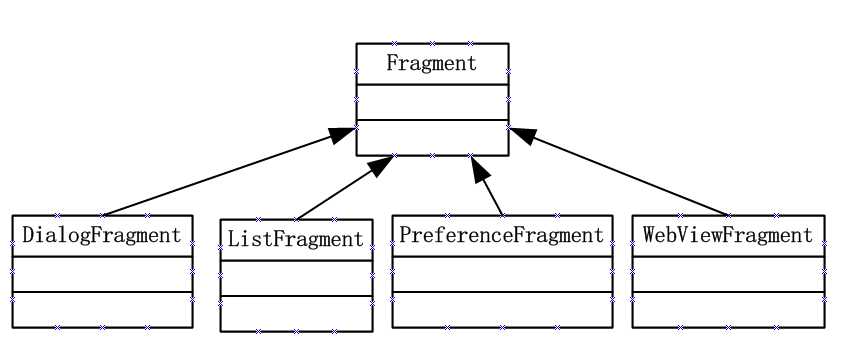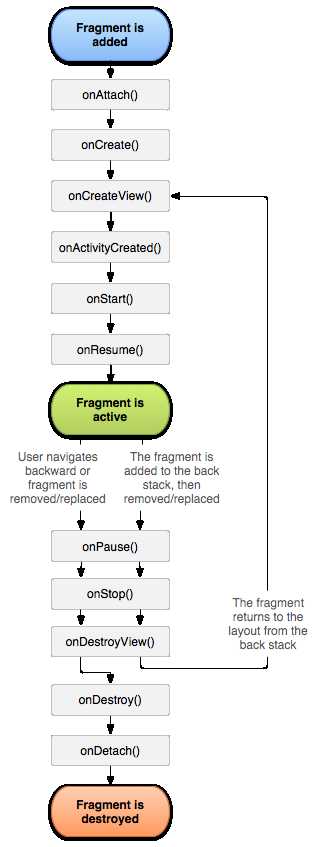1 Fragment简介
1.1 Fragment的设计初衷
Android3.0引入Fragment的初衷是为大屏幕的设备提供更加灵活的动态UI设计,由于大屏设备可以容纳更多的UI组件,且这些UI组件之间存在交互关系。Fragment简化了大屏UI的设计,它不需要开发者guan‘li管理组件包含关系的复杂变化,开发者使用Fragment对UI组件进行分组、模块化管理,可以更方便的动态更新Activity的用户界面。
1.2 Fragment特征
Fragment必须被“嵌入”Activity中使用,因此虽然Fragment也拥有自己的生命周期,但是Fragment的生命周期会受到它所在的Activity的生命周期控制:当Activity暂停时,其中所有的Fragment也暂停;当Activity被销毁时,其中所有的Fragment都会被销毁;只有当该Activity处于活动状态时,程序员可以通过方法独立操作Fragment。Fragment
具有如下特征:
1.3 Fragment的类继承关系

2 创建Fragment
开发Fragment与开发Activity非常相似,区别只是开发两者继承的类分别为Activity及其子类/Fragment及其子类。需要将原来写在Activity中的回调方法也需要在Fragment中实现。创建Fragment通常需要实现如下三个方法:创建时的回调方法onCreate()、绘制界面时的回调方法onCreateView()、用户离开Fragment时的回调方法onPause()
2.1 静态Fragment
使用Fragment最简单的一种方式,把Fragment当成普通的控件,直接写在Activity的布局文件中。步骤:
2.2 动态Fragment
Activity中的Fragment可以动态的添加、删除、更新。
注意:layout布局文件中包含子布局文件,用<include>元素
3 Fragment与Activity之间数据传输
3.1 对象的获取
将Fragment添加到Activity之后,Fragment必须与Activity交互信息,这就需要两者能在各自的空间中获取对方的对象。
3.2 数据的传递
示例:
Activity文件:

import android.app.Activity; import android.os.Bundle; public class SelectBookActivity extends Activity implements BookListFragment.Callbacks { @Override public void onCreate(Bundle savedInstanceState) { super.onCreate(savedInstanceState); // 加载/res/layout目录下的activity_book_twopane.xml布局文件 setContentView(R.layout.activity_book_twopane); } //实现Callbacks接口必须实现的方法,实现此方法从Fragment取数据 @Override public void onItemSelected(Integer id) { ///Activity向BookDetailFragment发送数据 Bundle arguments = new Bundle(); arguments.putInt(BookDetailFragment.ITEM_ID, id); BookDetailFragment fragment = new BookDetailFragment(); // 向Fragment传入参数 fragment.setArguments(arguments); // 使用fragment替换book_detail_container容器当前显示的Fragment getFragmentManager().beginTransaction() .replace(R.id.book_detail_container, fragment) .commit(); } }
向Activity发送数据的BookListFragment文件

import android.app.ListFragment; import android.os.Bundle; import android.view.View; import android.widget.ArrayAdapter; import android.widget.ListView; public class BookListFragment extends ListFragment { private Callbacks mCallbacks; // 定义一个回调接口,该Fragment所在Activity需要实现该接口 // 该Fragment将通过该接口与它所在的Activity交互 public interface Callbacks { void onItemSelected(Integer id); } @Override public void onCreate(Bundle savedInstanceState) { super.onCreate(savedInstanceState); // 为该ListFragment设置Adapter setListAdapter(new ArrayAdapter<>(getActivity(), android.R.layout.simple_list_item_activated_1, android.R.id.text1, BookContent.itemList)); } // 当该Fragment从它所属的Activity中被删除时回调该方法 @Override public void onDetach() { super.onDetach(); // 将mCallbacks赋为null。 mCallbacks = null; } // 当用户点击某列表项时激发该回调方法 @Override public void onListItemClick(ListView listView , View view, int position, long id) { super.onListItemClick(listView, view, position, id); // 获取Activity对象,以调用Callbacks回调方法 mCallbacks = (Callbacks) getActivity(); mCallbacks.onItemSelected((int)id); } }
从Activity接收数据的BookDetailFragment文件

import android.app.Fragment; import android.os.Bundle; import android.view.LayoutInflater; import android.view.View; import android.view.ViewGroup; import android.widget.TextView; public class BookDetailFragment extends Fragment { public static final String ITEM_ID = "item_id"; BookContent.Book book; @Override public View onCreateView(LayoutInflater inflater, ViewGroup container, Bundle savedInstanceState) { View rootView = inflater.inflate(R.layout.fragment_book_detail, container, false); //Fragment接收Activity传输过来的数据 Bundle bd = getArguments(); book = BookContent.itemList.get(bd.getInt(ITEM_ID)); ((TextView) rootView.findViewById(R.id.book_title)).setText(book.title); ((TextView) rootView.findViewById(R.id.book_desc)).setText(book.desc); return rootView; } }
Activity布局文件:

<?xml version="1.0" encoding="utf-8"?> <!-- 定义一个水平排列的LinearLayout,并指定使用中等分隔条 --> <LinearLayout xmlns:android="http://schemas.android.com/apk/res/android" android:orientation="horizontal" android:layout_width="match_parent" android:layout_height="match_parent" android:layout_marginLeft="16dp" android:layout_marginRight="16dp" android:divider="?android:attr/dividerHorizontal" android:showDividers="middle"> <!-- 添加一个Fragment --> <fragment android:name="com.example.penghuster.fragmenttest.BookListFragment" android:id="@+id/book_list" android:layout_width="0dp" android:layout_height="match_parent" android:layout_weight="1" />` <!-- 添加一个FrameLayout容器 --> <FrameLayout android:id="@+id/book_detail_container" android:layout_width="0dp" android:layout_height="match_parent" android:layout_weight="2" /> </LinearLayout>
DetailFragment布局文件:

<?xml version="1.0" encoding="utf-8"?> <LinearLayout xmlns:android="http://schemas.android.com/apk/res/android" android:layout_width="match_parent" android:layout_height="match_parent" android:orientation="vertical"> <!-- 定义一个TextView来显示图书标题 --> <TextView android:id="@+id/book_title" style="?android:attr/textAppearanceLarge" android:layout_width="match_parent" android:layout_height="wrap_content" android:hint="哈地方" android:padding="16dp" /> <!-- 定义一个TextView来显示图书描述 --> <TextView android:id="@+id/book_desc" style="?android:attr/textAppearanceMedium" android:layout_width="match_parent" android:layout_height="match_parent" android:padding="16dp" /> </LinearLayout>
4 Fragment管理与Fragment事物
4.1 FragmentManager
4.2FragmentTransaction
如果需要添加,删除,替换Fragment,则需要通过FragmentTransaction对象
5 Fragment的生命周期

原文:http://www.cnblogs.com/penghuster/p/4905754.html